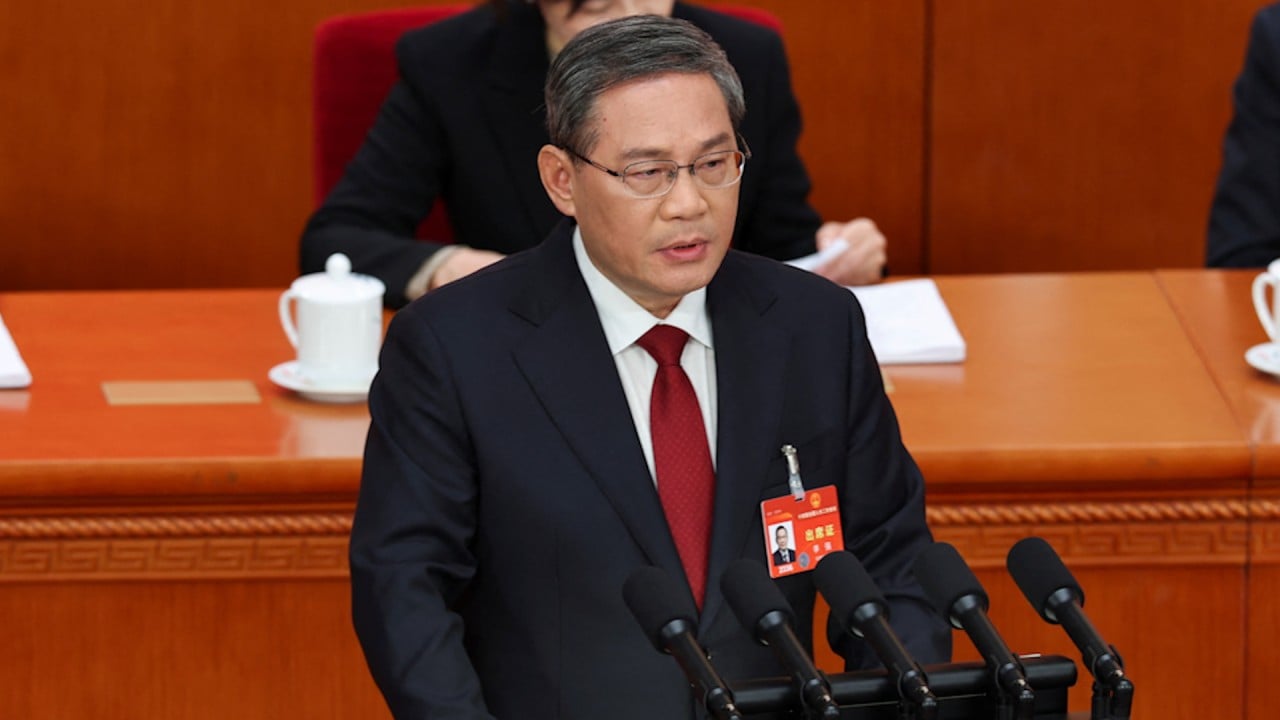
China’s 5% GDP growth target demands ‘hard work’, leaders insist while flagging hopes and risks
- The highly anticipated economic growth target for 2024 is on record, and with it lofty expectations for follow-through efforts by Beijing as big stimulus remains elusive
- China’s leadership acknowledges the goal faces internal and external headwinds while seeking to dispel mounting economic concerns
In the midst of a battering of headwinds that threaten to capsize China’s economic recovery, Beijing has offered assurances that it has enough tools in its proverbial financial kit to batten down the hatches, right the ship and quell the concerns of overseas investors.
To that end, leadership has set an ambitious goal of growing the economy by 5 per cent this year – a target that is in line with China’s growth potential and “is a positive goal reachable with a jump”, National Development and Reform Commission chief Zheng Shanjie told the press on Wednesday during the annual “two sessions” parliamentary gatherings.
He explained that the 2024 gross domestic product (GDP) growth target – the same as last year’s target – was the result of the central government’s comprehensive assessment, “taking into account current and long-term needs and possibilities”.
As it happened: Beijing defends GDP goal, vows crackdown on market defects
China’s economy has got off to a strong start in the first quarter of the year, Zheng said, as evidenced by power generation during January and February being up by 11.7 per cent, year on year – an indication of economic activity rising.
He also pointed to a rise in the number of tourists who ventured out during the Lunar New Year holiday week, marking a 19 per cent increase compared with pre-pandemic numbers in 2019.
However, even authorities conceded that grabbing hold of 5 per cent economic growth will not come as low-hanging fruit, due to the relatively high base of comparison with 2023 and in the face of persistent deflationary risks, a prolonged property market downturn, and mounting pressure from the West in areas such as tech and new energy.
Hurdles that threaten to stand in the way of the lofty GDP goal include challenges in developing a unified domestic market, an increasingly complex external environment, and the financial constraints that continue to hold back many firms, Zheng acknowledged.
In an effort to dispel market concerns on how Beijing will be able to achieve the ambitious target, central bank governor Pan Gongsheng also said at the press conference that Beijing’s monetary policy toolkit is still deep, and he signalled that further moves were in the works to lower lending costs for financial institutions and to address deflationary risks.
The economy right now looks like a hardworking middle-aged man … It probably needs to change its way of living
In setting monetary policy, China will focus on stabilising price levels while spurring a mild rebound in prices, and also on “maintaining the health of the banking sector’s balance sheet and pushing for a gradual decline in financing costs”, Pan said.
“The economy right now looks like a hardworking middle-aged man – it remains powerful and productive, but has started to catch some chronic diseases. It probably needs to change its way of living and switch gears instead,” said Xu Tianchen, a senior economist with the Economist Intelligence Unit (EIU).
And Capital Economics had said in a note on Tuesday that China’s policy support should underpin the need for near-term improvement while also addressing the need to ward off headwinds from trade woes and a property crisis that look to intensify over the coming year.
Premier’s promise-laden speech leaves China’s foreign, private firms ambivalent
“It is probably safe to assume that the growth target will be met, on paper,” its analysts added. “But unless stimulus goes beyond what has been signalled at the [National People’s Congress], we aren’t convinced that the economy will expand this quickly, in practice.”
Meanwhile, China is banking on replacement programmes for used cars, outdated equipment and consumer goods, in a bid to help boost economic activity.
Zheng said a large-scale trade-in programme for potentially billions of home appliances will be a multi-trillion-yuan market, benefiting both consumption and manufacturing.
Minister of Commerce Wang Wentao expanded on that sentiment.
“Promoting the replacement of old consumer goods with new ones is not only a powerful measure to enhance the current economic growth momentum and consolidate the recovery, it’s also a long-term strategy to promote high-quality development,” Wang said.
Zheng also pledged to give “full play” to the private sector when it comes to investment, highlighting that the sector accounts for more than 50 per cent of all investment in China.
Among its policy tools, China also aims to lean heavily on its “new three” exports – namely electric vehicles, lithium-ion batteries and solar panels – seeking to turn them into main economic drivers.
“The overall growth [of “new three” exports] has been 30 per cent from the year before … and it exemplifies that China is accelerating its transition from old to new economic engines, and that our manufacturing quality keeps improving,” Zheng said.
However, China’s 1 trillion yuan (US$139 billion) market for those types of exports could face a new smattering of challenges this year, as legal action and tariff increases by the United States and European Union against a perceived oversupply of cheap products could set back a critical segment of the world’s second-largest economy unless it diversifies away from the West and also boosts domestic demand, according to analysts.
Despite the significant roadblocks, the “new three” exports will continue to make inroads in the global market, the EIU’s Xu said.
“They are so competitive and so cheap that other markets will find them hard to resist unless their governments shut the door completely,” Xu said. “If there is any downside, it’s that they are probably not enough to offset declines elsewhere – such as in property.”
Additional reporting by Mia Nulimaimaiti



